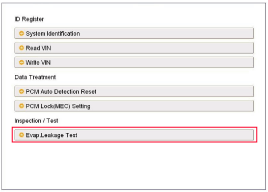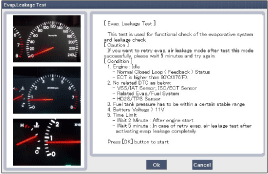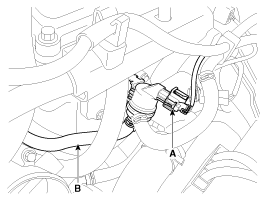Hyundai Elantra: Evaporative Emission Control System / Repair procedures
| Inspection |
| [EVAP. Leakage Test] |
| 1. |
Select "Evap. Leakage Test".
|
| 2. |
Proceed with the test according to the screen introductions.
|
| [PCSV Inspection] |
| 1. |
Turn ignition switch OFF and disconnect the negative (-) battery cable. |
| 2. |
Disconnect the PCSV connector (A). |
| 3. |
Disconnect the vapor hose (B) which is connected to the intake manifold from the PCSV.
|
| 4. |
After connecting a vacuum pump to the nipple, apply vacuum. |
| 5. |
With the PCSV control line grounded, check the valve
operation with battery voltage applied to the PCSV(Open) and removed
(Closed).
|
| 6. |
Measure the coil resistance of the PCSV.
|
 Schematic Diagrams
Schematic Diagrams
Schematic Diagram
Canister
The Canister is filled with charcoal and absorbs evaporated
fuel vapor from the fuel tank. The gathered fuel vapor in canister is
drawn into the intake manifold by t ...
 Canister Repair procedures
Canister Repair procedures
Removal
1.
Turn the ignition switch OFF and disconnect the battery negative (-) cable.
2.
Lift the vehicle.
3.
Disconnect the ventilation hose (A), and canister close valve extension co ...
Other information:
Hyundai Elantra AD (2016-2020) Service Manual: Engine Coolant Temperature Sensor (ECTS) Description and Operation
Description
Engine Coolant Temperature Sensor (ECTS) is located in the
engine coolant passage of the cylinder head for detecting the engine
coolant temperature. The ECTS uses a thermistor whose resistance changes
with the temperature.
The electrical resistance of the ECTS decreases as the ...
Hyundai Elantra AD (2016-2020) Owners Manual: Checking the tire inflation pressure
1. After driving approximately 7~10 km (4~6 miles or about 10 min), stop at a
safety location.
2. Connect the filling hose (3) directly into the compressor
3. Connect the other end of the filling hose (3) directly into the valve.
4. Plug the compressor power cord into the vehicle power outl ...



